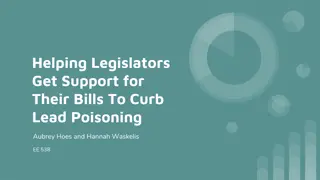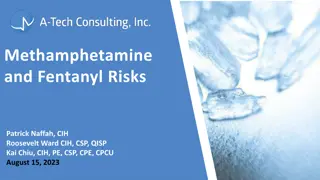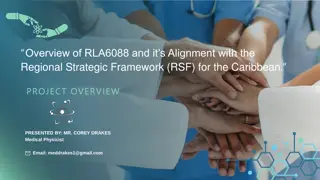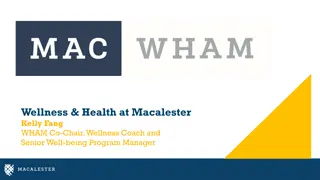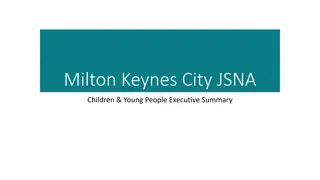Understanding the Impact of Lead Contamination on Human Health and Ecosystems
Exploring the detrimental effects of lead exposure on human health and the environment, this content touches on lead contamination in drinking water, its effects on various bodily systems, and its impact on ecosystems. It also delves into the history of lead usage, major contributors to lead pollution, and ways lead enters tap water. The content underscores the importance of regulations like the Clean Water Act and the role of the EPA in safeguarding human health and the environment against lead toxicity.
Download Presentation
Please find below an Image/Link to download the presentation.
The content on the website is provided AS IS for your information and personal use only. It may not be sold, licensed, or shared on other websites without obtaining consent from the author. Download presentation by click this link. If you encounter any issues during the download, it is possible that the publisher has removed the file from their server.
Presentation Transcript
Reducing Lead in Drinking Water in Indiana s Childcare Facilities
Nervous System Kidney Function Immune System Reproductive and Developmental Systems Reduces Oxygen in the Blood Neurological Effects in Children Behavioral Problems Learning Deficits Lowered IQ How lead effects human health
Effects of Lead on Ecosystems Soil Water Bodies, Lakes Rivers and Streams Air Pollution Mining
American Steel Foundries - Amsted Industries Whiting Metals Inland Steel Unilever American Maze Major Contributors that have Affected our Ecosystem Indiana Harbor Belt Railroad Headquarters State Line Plant Standard of Indiana - Amoco - British Petroleum US Reduction Co Bethlehem Steel Sherwin Williams Paint Plant LVT Republic Steel U.S. Steel South Works U.S. Steel Gary Works Sinclair Oil Co - Atlantic Richfield - Energy Cooperative Shell Oil Co - Staffer Chemical Co now Rhone Poulenc Basic Chemicals Co Vista Chemical Co Cities Service Oil Co Socony Vacuum Co - Maguire Oil Co and Wadhams Oil Co - Mobile
Leaded gas Introduced in the 1970 s phased out January 1, 1996. for on road vehicles.
The first major U. S. law to address water pollution. Federal Water Pollution Act established in 1948. In 1972 it was amended to become the Clean Water Act.
United States Environmental Protection Act (EPA) Established December 2, 1970. EPA s mission is to protect human health and the environment.
Lead Pipes Faucets Plumbing fixtures Pipe fittings made prior to 1986 Common Sources of Lead in Drinking Water
How lead gets into tap water Brass or Chrome plated-brass faucets Plumbing soldered with lead Lead service lines Galvanized Iron Pipes
Drinking Water Fountains with lead lined tanks are not intended for drinking water!
Corrosion Dissolving or wearing away of metal from the pipes and fixtures
How much lead enters water is related to: Types and amounts of minerals in the water Amount of lead that water comes into contact with Acidity or alkalinity of the water Amount of wear in the pipes How long the water stays in pipes Water temperature Presence of protective scales or coatings in the pipes.
Is your tap water contaminated with lead?
Risk from lead in water Bathing and showering should be safe for you and your children because human skin does not absorb lead in water. NO safe lead blood level for young children. All sources of lead exposure for children should be controlled or eliminated. The EPA has set the maximum contaminant level goal for lead in drinking water at zero because lead can be harmful to human health even at low exposure levels. Lead is a toxic metal that is persistent in the environment and can accumulate in the body over time. Risk will vary depending on the individual, the chemical conditions of the water, and the amount consumed.
Have your child tested for lead exposure Contact your health care provider.
How to reduce or eliminate exposure to lead in tap water Drinking or using only tap water that has been run through a point-of-use to reduce lead (NSF/ANSI standard 53 for lead removal and NSF/ANSI standard 42 for particulate removal).
House Enrolled Act 1138 Preschool and childcare facility drinking water Signed into law May 1, 2023. All Childcare and preschools in the state of Indiana must test the drinking water through the Indiana Finance Authority for lead before January 1, 2026. Remediation is to occur if test reveals 15 ppb or more of lead in the water. When remediating the problems, the facility must use filters that are NSF/ANSI approved.
Carolyn B. Jackson State Representative District 1 200 W. Washington Street Thank You Indianapolis, IN 46204 1-800 382-9842 - 317 232-9794 Carolyn.Jackson@iga.in.gov




